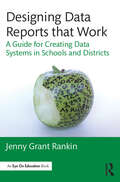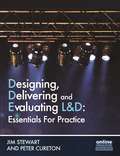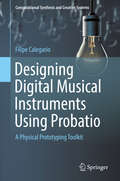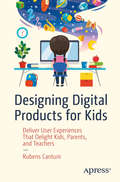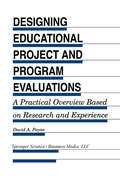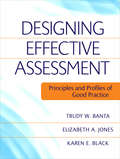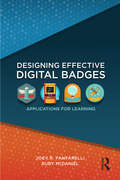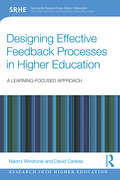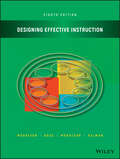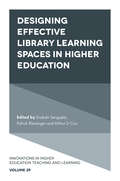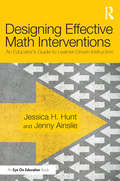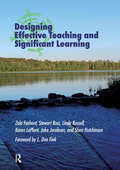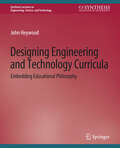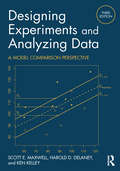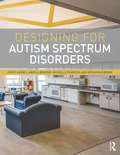- Table View
- List View
Designing Data Reports that Work: A Guide for Creating Data Systems in Schools and Districts
by Jenny Grant RankinDesigning Data Reports that Work provides research-based best practices for constructing effective data systems in schools and for designing reports that are relevant, necessary, and easily understood. Clear and coherent data systems and data reports significantly improve educators’ data use and save educators time and frustration. The strategies in this book will help those responsible for designing education data reports—including school leaders, administrators, and educational technology vendors—to create productive data reports individualized for each school or district. This book breaks down the key concepts in creating and implementing data systems, ensuring that you are a better partner with teachers and staff so they can work with and use data correctly and improve teaching and learning.
Designing Data Reports that Work: A Guide for Creating Data Systems in Schools and Districts
by Jenny Grant RankinDesigning Data Reports that Work provides research-based best practices for constructing effective data systems in schools and for designing reports that are relevant, necessary, and easily understood. Clear and coherent data systems and data reports significantly improve educators’ data use and save educators time and frustration. The strategies in this book will help those responsible for designing education data reports—including school leaders, administrators, and educational technology vendors—to create productive data reports individualized for each school or district. This book breaks down the key concepts in creating and implementing data systems, ensuring that you are a better partner with teachers and staff so they can work with and use data correctly and improve teaching and learning.
Designing, Delivering and Evaluating L&D: Essentials for Practice
by Jim Stewart Peter John CuretonAs the global economy has changed and thus organizations with it, more learning is delivered at and through work and individuals are encouraged to utilise the opportunities that advances in technology have brought to take charge of their own learning. Essential reading for the CIPD Level 7 Advanced postgraduate unit Designing, Delivering and Evaluating Learning and Development Provision, Designing, Delivering and Evaluating L&D critically examines the contextual factors impacting upon these activities in organizations. With case studies from the public, private and voluntary sectors as well as examples of international practice, the book helps to identify some of the challenges L&D professionals face in a range of environments. Designing, Delivering and Evaluating L&D is suitable not just for students working towards a CIPD Level 7 qualification, but also for those studying more general business and management degrees, as well as anyone who may have studied the subject previously and wishes to engage in continuous professional development with regard to this key HR practice. Online supporting resources include an instructor's manual, lecture slides and web links.
Designing, Delivering and Evaluating L&D: Essentials for Practice (PDF)
by Jim Stewart Peter John CuretonAs the global economy has changed and thus organizations with it, more learning is delivered at and through work and individuals are encouraged to utilise the opportunities that advances in technology have brought to take charge of their own learning. Essential reading for the CIPD Level 7 Advanced postgraduate unit Designing, Delivering and Evaluating Learning and Development Provision, Designing, Delivering and Evaluating L&D critically examines the contextual factors impacting upon these activities in organizations. With case studies from the public, private and voluntary sectors as well as examples of international practice, the book helps to identify some of the challenges L&D professionals face in a range of environments. Designing, Delivering and Evaluating L&D is suitable not just for students working towards a CIPD Level 7 qualification, but also for those studying more general business and management degrees, as well as anyone who may have studied the subject previously and wishes to engage in continuous professional development with regard to this key HR practice. Online supporting resources include an instructor's manual, lecture slides and web links.
Designing Democratic Schools and Learning Environments: A Global Perspective
by Linda F. Nathan Jonathan F. Mendonca Gustavo Rojas AyalaThis open access book explores democratic schools and learning environments globally. The book focuses on a newly developed framework for democratic education. The authors describe existing schools and concept schools—those that are ideas but not in operation. The first section includes the editors’ own journeys. Pillar 1 includes schools that emphasize the open flow of ideas and choices, regardless of their popularity. Pillar 2 maintains that it is impossible to have a high quality education that ignores equity. Chapters explore how many diverse ‘marginalized’ communities experience education and some innovations that hold great promise for inclusion. Pillar 3 provides examples of schools where active engagement, consensus and compromise support the ‘common good.’ Pillar 4 investigates schools which organize students, parents, social institutions and the larger community collaboratively to achieve its goals and to solve theirs and society’s most urgent challenges.
Designing Digital Musical Instruments Using Probatio: A Physical Prototyping Toolkit (Computational Synthesis and Creative Systems)
by Filipe CalegarioThe author presents Probatio, a toolkit for building functional DMI (digital musical instruments) prototypes, artifacts in which gestural control and sound production are physically decoupled but digitally mapped. He uses the concept of instrumental inheritance, the application of gestural and/or structural components of existing instruments to generate ideas for new instruments. To support analysis and combination, he then leverages a traditional design method, the morphological chart, in which existing artifacts are split into parts, presented in a visual form and then recombined to produce new ideas. And finally he integrates the concept and the method in a concrete object, a physical prototyping toolkit for building functional DMI prototypes: Probatio. The author's evaluation of this modular system shows it reduces the time required to develop functional prototypes. The book is useful for researchers, practitioners, and graduate students in the areas of musical creativity and human-computer interaction, in particular those engaged in generating, communicating, and testing ideas in complex design spaces.
Designing Digital Products for Kids: Deliver User Experiences That Delight Kids, Parents, and Teachers
by Rubens CantuniChildhood learning is now more screen-based than ever before, and app developers are flocking in droves to this lucrative and exciting market. The younger generation deserves the best, and growing up in a digital world has made them discerning and demanding customers. Creating a valuable user experience for a child is as complex and involved as when designing a typical app for an adult, if not more, and Designing Digital Products for Kids is here to be your guide. Author and designer Rubens Cantuni recognizes the societal importance of a high-quality and ethical app experience for children. There is room for significant improvement in this space, and Cantuni helps you optimize it. Designing Digital Products for Kids walks hopeful developers through digital product design—including research, concept, design, release, marketing, testing, analyzing, and iterating—all while aiming to build specifically for children. Industry experts and their real-world advice are showcased in this book, along with careful advice for the ethics that go along with this unique market. These tips include complex needs regarding mental development, accessibility, conscious screen time limits, and content sensitivity. Children, parents, and teachers alike are hungry for more thoughtful players in the kids’ app space, and Designing Digital Products for Kids is your ticket to successfully developing and educating for the future. What You Will LearnDesign platforms specifically for children, to entertain and educate themWork with a complex audience of parents, teachers and kidsUnderstand how different monetization strategies work in this industry and why Who This Book Is ForUser experience designers, UI designers, product owners, teachers and educators, startup founders. The range of topics is so wide that anyone interested or involved in digital products could find something interesting to learn.
Designing Discussion for Online and Blended Courses: A Forum for Learning in Higher Education (SpringerBriefs in Education)
by Dianne Forbes Nicola Daly Liang LiThis book supports teaching and learning through online discussion in higher education contexts such as universities, colleges, and polytechnics. It presents an explicit focus on popular asynchronous discussion tools and methods, with attention to disciplinary variety and key principles for successful learning-oriented discussion. It tackles the challenges faced by tertiary teachers implementing online discussion, and outlines common concerns and productive solutions to enhance the effectiveness and manageability of online discussions for teachers. This book also presents a parallel focus on the difficulties commonly experienced by students learning through online discussion. It offers advice for new online learners in a practical and accessible way, and considers assessment issues related to online discussion. Finally, this book offers innovative ideas for future-oriented online discussion in the higher education context.
Designing Educational Project and Program Evaluations: A Practical Overview Based on Research and Experience (Evaluation in Education and Human Services #38)
by David A. PayneDrawing upon experiences at state and local level project evaluation, and based on current research in the professional literature, Payne presents a practical, systematic, and flexible approach to educational evaluations. Evaluators at all levels -- state, local and classroom -- will find ideas useful in conducting, managing, and using evaluations. Special user targets identified are state department of education personnel and local school system administrative personnel. The volume can be used by those doing evaluation projects `in the field', or as a text for graduate courses at an introductory level. The book begins with an overview of the generic evaluation process. Chapter Two is devoted to the criteria for judging the effectiveness of evaluation practice. Chapter Three addresses the all important topic of evaluation goals and objectives. Chapters Four, Five and Six basically are concerned with the approach, framework, or design of an evaluation study. Chapter Four contains a discussion of four major philosophical frameworks or metaphors and the implications of these frameworks for conducting an evaluation. Chapters Five and Six describe predominantly quantitative and qualitative designs, respectively. Design, implementation and operational issues related to instrumentation (Chapter Seven), management and decision making (Chapter Eight), and reporting and utilization of results (Chapter Nine) are next addressed. The final chapter of the book (Chapter Ten) considers the evaluation of educational products and materials.
Designing Effective Assessment: Principles and Profiles of Good Practice
by Trudy W. Banta Elizabeth A. Jones Karen E. BlackFifteen years ago Trudy Banta and her colleagues surveyed the national landscape for the campus examples that were published in the classic work Assessment in Practice. Since then, significant advances have occurred, including the use of technology to organize and manage the assessment process and increased reliance on assessment findings to make key decisions aimed at enhancing student learning. Trudy Banta, Elizabeth Jones, and Karen Black offer 49 detailed current examples of good practice in planning, implementing, and sustaining assessment that are practical and ready to apply in new settings. This important resource can help educators put in place an effective process for determining what works and which improvements will have the most impact in improving curriculum, methods of instruction, and student services on college and university campuses.
Designing Effective Digital Badges: Applications for Learning
by Joey R. Fanfarelli Rudy McDanielDesigning Effective Digital Badges is a hands-on guide to the principles, implementation, and assessment of digital badging systems. Informed by the fundamental concepts and research-based characteristics of effective badge design, this book uses real-world examples to convey the advantages and challenges of badging and showcase its application across a variety of contexts. Professionals in education, game development, mobile app development, and beyond will find strategies for practices such as credentialing, goal-setting, and motivation of their students.
Designing Effective Digital Badges: Applications for Learning
by Joey R. Fanfarelli Rudy McDanielDesigning Effective Digital Badges is a hands-on guide to the principles, implementation, and assessment of digital badging systems. Informed by the fundamental concepts and research-based characteristics of effective badge design, this book uses real-world examples to convey the advantages and challenges of badging and showcase its application across a variety of contexts. Professionals in education, game development, mobile app development, and beyond will find strategies for practices such as credentialing, goal-setting, and motivation of their students.
Designing Effective Feedback Processes in Higher Education: A Learning-Focused Approach (Research into Higher Education)
by Naomi Winstone David CarlessFeedback is one of the most powerful influences on student achievement, yet it is difficult to implement productively within the constraints of a mass higher education system. Designing Effective Feedback Processes in Higher Education: A Learning-Focused Approach addresses the challenges of developing effective feedback processes in higher education, combining theory and practice to equip and empower educators. It places less emphasis on what teachers do in terms of providing commentary, and more emphasis on how students generate, make sense of, and use feedback for ongoing improvement. Including discussions on promoting student engagement with feedback, technology-enabled feedback, and effective peer feedback, this book: Contributes to the theory and practice of feedback in higher education by showcasing new paradigm feedback thinking focused on dialogue and student uptake Synthesises the evidence for effective feedback practice Provides contextualised examples of successful innovative feedback designs analysed in relation to relevant literature Highlights the importance of staff and student feedback literacy in developing productive feedback partnerships Supports higher education teachers in further developing their feedback practice. Designing Effective Feedback Processes in Higher Education: A Learning-Focused Approach contributes to the theory and practice of higher education pedagogy by re-evaluating how feedback processes are designed and managed. It is a must-read for educators, researchers, and academic developers in higher education who will benefit from a guide to feedback research and practice that addresses well recognised challenges in relation to assessment and feedback.
Designing Effective Feedback Processes in Higher Education: A Learning-Focused Approach (Research into Higher Education)
by Naomi Winstone David CarlessFeedback is one of the most powerful influences on student achievement, yet it is difficult to implement productively within the constraints of a mass higher education system. Designing Effective Feedback Processes in Higher Education: A Learning-Focused Approach addresses the challenges of developing effective feedback processes in higher education, combining theory and practice to equip and empower educators. It places less emphasis on what teachers do in terms of providing commentary, and more emphasis on how students generate, make sense of, and use feedback for ongoing improvement. Including discussions on promoting student engagement with feedback, technology-enabled feedback, and effective peer feedback, this book: Contributes to the theory and practice of feedback in higher education by showcasing new paradigm feedback thinking focused on dialogue and student uptake Synthesises the evidence for effective feedback practice Provides contextualised examples of successful innovative feedback designs analysed in relation to relevant literature Highlights the importance of staff and student feedback literacy in developing productive feedback partnerships Supports higher education teachers in further developing their feedback practice. Designing Effective Feedback Processes in Higher Education: A Learning-Focused Approach contributes to the theory and practice of higher education pedagogy by re-evaluating how feedback processes are designed and managed. It is a must-read for educators, researchers, and academic developers in higher education who will benefit from a guide to feedback research and practice that addresses well recognised challenges in relation to assessment and feedback.
Designing Effective Library Learning Spaces in Higher Education (Innovations in Higher Education Teaching and Learning #29)
by Enakshi Sengupta, Patrick Blessinger, Milton D. CoxModern academic libraries must respond not only to pedagogical changes, but to technological changes. Accommodating advances in technology into library space, design, and management is a critical challenge. How can modern libraries successfully integrate traditional learnings forms with digital ones? This book presents case studies and empirical evidence which focus on the current landscape and future potential posed by the changing face of libraries. Readers are invited to learn how the re-modelling and new architectural design of existing libraries can revitalise the library space and inculcate digital literacy development within their walls. The authors offer an engaging account of how libraries’ meet users’ needs and utilize stakeholder inputs to design truly innovative library spaces.
Designing Effective Library Learning Spaces in Higher Education (Innovations in Higher Education Teaching and Learning #29)
by Enakshi Sengupta Patrick Blessinger Milton D. CoxModern academic libraries must respond not only to pedagogical changes, but to technological changes. Accommodating advances in technology into library space, design, and management is a critical challenge. How can modern libraries successfully integrate traditional learnings forms with digital ones? This book presents case studies and empirical evidence which focus on the current landscape and future potential posed by the changing face of libraries. Readers are invited to learn how the re-modelling and new architectural design of existing libraries can revitalise the library space and inculcate digital literacy development within their walls. The authors offer an engaging account of how libraries’ meet users’ needs and utilize stakeholder inputs to design truly innovative library spaces.
Designing Effective Math Interventions: An Educator's Guide to Learner-Driven Instruction
by Jessica H. Hunt Jenny AinslieDesign effective, learner-driven math interventions with this accessible and thought-provoking guidebook. Learn how to set up instruction to promote participation and understanding, plan purposeful, targeted tasks, develop student thinking, and create tools to assess student work in a way that measures learning, not just performance. Chapters explore questions that educators frequently struggle with when designing interventions, offering user-friendly research and evidence-based strategies to help overcome common hurdles. This book is essential reading for anyone seeking an adaptive approach to Tier 2 and 3 interventions that positions struggling students as competent learners.
Designing Effective Math Interventions: An Educator's Guide to Learner-Driven Instruction
by Jessica H. Hunt Jenny AinslieDesign effective, learner-driven math interventions with this accessible and thought-provoking guidebook. Learn how to set up instruction to promote participation and understanding, plan purposeful, targeted tasks, develop student thinking, and create tools to assess student work in a way that measures learning, not just performance. Chapters explore questions that educators frequently struggle with when designing interventions, offering user-friendly research and evidence-based strategies to help overcome common hurdles. This book is essential reading for anyone seeking an adaptive approach to Tier 2 and 3 interventions that positions struggling students as competent learners.
Designing Effective Teaching and Significant Learning
by Zala Fashant Linda Russell Stewart Ross Jake Jacobson Karen LaPlantDesigning courses to deliver effective teaching and significant learning is the best way to set students up for success, and this book guides readers through the process. The authors have worked with faculty world-wide, and share the stories of how faculty have transformed courses from theory to practice. They start with Dee Fink’s foundation of integrating course design. Then they provide additional design concepts to expand the course blueprint to implement plans for communication, accessibility, technology integration, as well as the assessment of course design as it fits into the assessment of programs and institutions, and how faculty can use what they learn to meet their professional goals.
Designing Effective Teaching and Significant Learning
by Zala Fashant Linda Russell Stewart Ross Jake Jacobson Karen LaPlantDesigning courses to deliver effective teaching and significant learning is the best way to set students up for success, and this book guides readers through the process. The authors have worked with faculty world-wide, and share the stories of how faculty have transformed courses from theory to practice. They start with Dee Fink’s foundation of integrating course design. Then they provide additional design concepts to expand the course blueprint to implement plans for communication, accessibility, technology integration, as well as the assessment of course design as it fits into the assessment of programs and institutions, and how faculty can use what they learn to meet their professional goals.
Designing Engineering and Technology Curricula: Embedding Educational Philosophy (Synthesis Lectures on Engineering, Science, and Technology)
by John HeywoodThe intention of this book is to demonstrate that curriculum design is a profoundly philosophical exercise that stems from perceptions of the mission of higher education. Since the curriculum is the formal mechanism through which intended aims are achieved, philosophy has a profound role to play in the determination of aims. It is argued that the curriculum is far more than a list of subjects and syllabi, or that it is the addition, and subtraction, of items from a syllabus, or whether this subject should be added and that subject taken away. This book explores how curricular aims and objectives are developed by re-examining the curriculum of higher education and how it is structured in the light of its increasing costs, rapidly changing technology, and the utilitarian philosophy that currently governs the direction of higher education. It is concluded that higher education should be a preparation for and continuing support for life and work, a consequence of which is that it has to equip graduates with skill in independent learning (and its planning), and reflective practice. A transdisciplinary curriculum with technology at its core is deduced that serves the four realities of the person, the job, technology, and society.
Designing Experiments and Analyzing Data: A Model Comparison Perspective, Third Edition
by Scott E. Maxwell Harold D. Delaney Ken KelleyDesigning Experiments and Analyzing Data: A Model Comparison Perspective (3rd edition) offers an integrative conceptual framework for understanding experimental design and data analysis. Maxwell, Delaney, and Kelley first apply fundamental principles to simple experimental designs followed by an application of the same principles to more complicated designs. Their integrative conceptual framework better prepares readers to understand the logic behind a general strategy of data analysis that is appropriate for a wide variety of designs, which allows for the introduction of more complex topics that are generally omitted from other books. Numerous pedagogical features further facilitate understanding: examples of published research demonstrate the applicability of each chapter’s content; flowcharts assist in choosing the most appropriate procedure; end-of-chapter lists of important formulas highlight key ideas and assist readers in locating the initial presentation of equations; useful programming code and tips are provided throughout the book and in associated resources available online, and extensive sets of exercises help develop a deeper understanding of the subject. Detailed solutions for some of the exercises and realistic data sets are included on the website (DesigningExperiments.com). The pedagogical approach used throughout the book enables readers to gain an overview of experimental design, from conceptualization of the research question to analysis of the data. The book and its companion website with web apps, tutorials, and detailed code are ideal for students and researchers seeking the optimal way to design their studies and analyze the resulting data.
Designing Experiments and Analyzing Data: A Model Comparison Perspective, Third Edition (The\inquiry And Pedagogy Across Diverse Contexts Ser.)
by Scott E. Maxwell Harold D. Delaney Ken KelleyDesigning Experiments and Analyzing Data: A Model Comparison Perspective (3rd edition) offers an integrative conceptual framework for understanding experimental design and data analysis. Maxwell, Delaney, and Kelley first apply fundamental principles to simple experimental designs followed by an application of the same principles to more complicated designs. Their integrative conceptual framework better prepares readers to understand the logic behind a general strategy of data analysis that is appropriate for a wide variety of designs, which allows for the introduction of more complex topics that are generally omitted from other books. Numerous pedagogical features further facilitate understanding: examples of published research demonstrate the applicability of each chapter’s content; flowcharts assist in choosing the most appropriate procedure; end-of-chapter lists of important formulas highlight key ideas and assist readers in locating the initial presentation of equations; useful programming code and tips are provided throughout the book and in associated resources available online, and extensive sets of exercises help develop a deeper understanding of the subject. Detailed solutions for some of the exercises and realistic data sets are included on the website (DesigningExperiments.com). The pedagogical approach used throughout the book enables readers to gain an overview of experimental design, from conceptualization of the research question to analysis of the data. The book and its companion website with web apps, tutorials, and detailed code are ideal for students and researchers seeking the optimal way to design their studies and analyze the resulting data.
Designing for Autism Spectrum Disorders
by Angela Bourne Michelle Pearson Kristi Gaines Mesha KleibrinkWinner of the 2017 IDEC Book Award, 2017 EDRA Great Places Award (Book Category), 2017 American Society of Interior Designers Joel Polsky Prize and the 2016 International Interior Design Association TXOK Research Award Designing for Autism Spectrum Disorders explains the influence of the natural and man-made environment on individuals with autism spectrum disorders (ASD) and other forms of intellectual/developmental disabilities (IDD). Drawing on the latest research in the fields of environmental psychology and education, the authors show you how architecture and interior spaces can positively influence individuals with neurodiversities by modifying factors such as color, lighting, space organization, textures, acoustics, and ventilation. Now you can design homes, therapeutic environments, work environments, and outdoor spaces to encourage growth and learning for the projected 500,000 children with ASD (in the United States alone) who are expected to reach adulthood by 2024. Topics discussed include:-Environmental design theories-Symptoms of ASD-Sensory processing deficits -Design needs of individuals on the spectrum at all ages-Design methods and solutions for spaces, including residential, learning, work, and therapeutic environments encompassing a wide range of budgets-Designing for self-actualization, well-being, and a high quality of life for the duration of an individual's life-Avenues for healthy living and aging in place-Biophilic design-Environmental impact on well-being -Strategies to promote active living as an integral part of the welfare focus.
